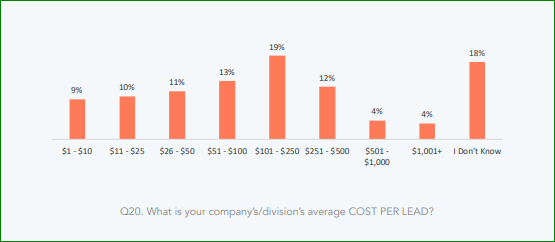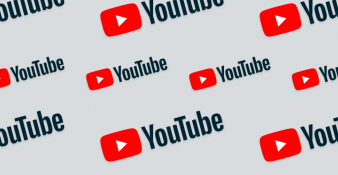Top digital marketing metrics for your business in 2020

Not all digital marketing metrics and channels are critical to your business. Focus on KPIs that directly impact your revenue and channels that generate the highest conversions for your business.
According to Smart Insights, there were 120+ content delivery and marketing channels in 2017. Given all these mediums, marketers are confused about which digital marketing metrics to track and prioritize.
While the metrics you choose may vary depending on your goal and strategy, a handful of metrics are important to your top executives. These metrics have a direct impact on the company’s bottom line and easily reveal whether marketing campaigns are effective in targeting potential customers.
Metrics to measure:
1. Cost per lead per channel
Cost per lead (CPL) refers to the average amount of money you spend to generate a new lead or potential customer. Tracking CPL per channel offers a lot of advantages. It lets you know which channels generate the most leads for the least cost, i.e., the effective and most cost-efficient channels for your business. It helps you decide which marketing channel gets a higher marketing budget allocation, and which ones to cut or drop in your next marketing campaign.
CPLs vary across industries. In a 2013 study conducted by Madison Logic on B2B lead generation, the health industry had the highest average CPL ($65), while marketing had the lowest, with a CPL of $35. In HubSpot’s 2017 Demand Generation Benchmarks Report covering over 350 companies, the average CPL was $198.44.

Determining your CPL per channel
To calculate your CPL per channel, take the total amount you’ve spent for each channel within a specific period (ex., per quarter). Then divide it by the number of leads generated through that channel within that time period.
For example, if your company spent $5,000 for pay-per-click (PPC) advertising in company A and generated 25 leads, your CPL for that channel is $200.
If your company spent the same amount for PPC in company B and generated 50 leads, your CPL for this channel is only $100.
In this example, advertising in channel B is more cost-efficient for your business.
Tips when determining your CPL
The definition of what is a “lead” varies among organizations and even among sales and marketing teams. Marketo, for instance, defines a lead as “a qualified prospect that is starting to exhibit buying behavior.” Meanwhile, Salesforce defines a lead as “anyone who has shown interest in a company’s products or services but may not yet be qualified to buy.”
When counting your leads and tracking your CPL, sit down with your marketing and sales teams to discuss how your business would define a good lead. Then put systems in place to help your team track CPLs per channel.
2. Conversion rate
Conversion rate may mean different things, depending on whether you are referring to sales (as in e-commerce sites) or leads (for other business websites).
Conversion rate for e-commerce
For e-commerce sites, conversion rate is the percentage of your site visitors who actually buy from your store. To compute the conversion rate, take your total sales, divide it by your total site visitors, and multiply the result by 100.
For example, if your store had 10,000 visitors in January and you generated 200 sales within that month, your conversion rate is 2%.
Conversion rate for leads
If you are not running an e-commerce business, your conversion rate will be the percentage of site visitors who made a specific action. This may be visitors who downloaded an ebook or report, created a free account, signed up for a webinar, or subscribed to your email list.
To compute your conversion rate, take your total signups, divide it by your total site visitors, and multiply the result by 100.
Tracking conversion rates is a must for businesses because it lets you know whether your site is making money or helping the company reach its sales and revenue targets.
Tracking your conversion rate
Google Analytics offers e-commerce and non-e-commerce sites a way to track their conversion rates.
For e-commerce sites, enable e-commerce in your reports and add the JavaScript code on your website or app. For other businesses, start by creating a goal in Google Analytics and completing goal configuration options.
You can even use the URL Builder in Google Analytics to create a tracking code for specific campaigns such as email newsletters. This way, your tracking can be as accurate as possible.
In the same way that you get your CPL per channel, you would want to track your conversions per channel as well. This lets you know which channels are generating the highest revenues or leads.
Improving your conversion rate
Low conversion rates prompt you to find ways to optimize your conversion rate. You can improve your conversion rate by changing your landing page design, improving your offer, optimizing your sales funnel, A/B testing, or using other strategies or a combination of these.
Ecommerce sites can do a lot of adjustments to increase conversion rates. They can create video ads showcasing their products’ benefits, offer discounts or free shipping, optimize for mobile, and decrease their site loading speed. For more tips on how to improve e-commerce conversion rates, check out these 20 tips from RedStag Fulfillment.

3. Return on ad spend
Return on ad spend (ROAS) refers to the total revenue you get for the total amount you spend on advertising. Measuring your ROAS lets you see how well your ad campaigns are boosting your company’s profit, which campaigns are generating good results, and which ones need to be pulled back.
ROAS = gross revenue from an ad campaign / total cost of an ad campaign
Note: Return on ad spend only gives you an idea of how well your ad is doing. It doesn't help you check if your ads are profitable. To calculate this, you need to take additional bits of data into consideration. These include material cost, labor, average credit card processing fees, shipping fees, etc.
Sometimes some of your other marketing strategies such as SEO and outreach will positively influencer your ROAS. Therefore, you need to consider them too, to check if your ads are profitable
Now that we’ve discussed the most important digital marketing metrics for your business, let’s look at the top trends that have been disrupting the digital marketing industry. See which ones you can leverage to improve your company’s lead generation and marketing strategies.
Digital marketing trends to maximize in 2020:
1. Facebook and Instagram
Globally, Facebook is still the most popular social media platform, with 2.38 billion active users as of July 2019. Other Facebook-owned companies also topped the list: WhatsApp (1.6 billion users), Messenger (1.3 billion users), and Instagram (1 billion users).
Given these platforms’ reach, businesses need to learn how to maximize their marketing campaigns on Facebook and Instagram. Marketing strategies in both platforms become even more powerful when combined with other digital marketing trends such as chatbots, video marketing, and influencer marketing.
When choosing the best social media channels, businesses need to think about their target demographic. According to the Pew Research Center’s 2019 survey, the majority of U.S. adults use Facebook, but Instagram remains popular among Americans aged 18-29. Companies targeting millennials and post-millennials may thus pour more efforts an Instagram than businesses catering to Baby Boomers and Generation X.

2. Chatbots
According to Salesforce’s March 2019 “State of Service” research report, AI chatbot use is expected to grow by 136% in the next 18 months. Chatbots are being used to address simple queries or gather initial information before problems are passed to agents. This is helping free up customer service agents so they can focus on addressing complex concerns.
Aside from boosting customer support, chatbots are now used to personalize the customer experience, improve conversion rates, and increase customer lifetime value.
3. Video content and marketing
Video content has become a very efficient and effective digital marketing tool. Video interviews, tutorials, and product demos allow businesses to promote brand and product awareness, increase engagement, and boost conversions. Among professional marketers and small to medium-sized businesses surveyed by Animoto, 76.5% said video marketing had a direct effect on their business, and more than half planned to increase their video investment.
4. Influencer marketing
Influencer marketing taps social media users with a significant following to improve brand awareness, reach, and conversions. It has become so effective because influencers have already established a level of trust with their followers and engage more often with their audience.
In YouTube, for instance, 70% of teenage subscribers feel they can relate better to YouTube creators than celebrities. Also, 6 in 10 subscribers will follow purchasing advice made by their favorite YouTube creator.
Influencer marketing is particularly popular on Instagram, where the global market is expected to almost double by 2020.
5. Content remains king
Content continues to play a critical role in all marketing strategies: SEO, paid advertising, inbound marketing, and social media marketing. Content types are often matched with specific stages in the sales funnel and can range from videos to infographics, podcasts, email series, white papers, case studies, and blogs.
For content to stand out and encourage conversions, it needs to add value and emphasize the benefits customers get from products and services. As mentioned above, you need to track conversion rates so you would know which content marketing strategies or channels are generating the highest revenues or leads.
6. Voice Search
Voice search is no longer just a fad. In the U.S., voice commerce sales were at $1.8 billion in 2017 and is expected to reach $40 billion by 2022. Voice shopping is also expected to grow in the U.K., from $0.2 billion in 2017 to $5 billion by 2022.
More and more, consumers are relying on voice search to find information on local businesses. This makes it a must for businesses to start optimizing their site for voice search.
Takeaway
In order to improve your marketing and sales results, you need to know your current performance. If you’re running a lean team, it will be difficult, if not impossible, to track all digital marketing metrics. It is also inefficient to spread your marketing efforts and budget equally across all channels.
Start by tracking the most important metrics that impact your company’s bottom line: CPL, conversion rates, and ROAS. Before each campaign, set up your digital marketing dashboard so you can easily track performance per channel. Lastly, see how you can take advantage of the top digital trends to bolster your KPIs in existing channels or create new campaigns to reach more leads.













